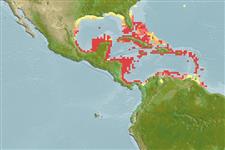>
Eupercaria/misc (Various families in series Eupercaria) >
Scaridae (Parrotfishes) > Sparisomatinae
Etymology: Sparisoma: Latin, sparus = a fish with a golden head + Greek, soma = body (Ref. 45335).
More on author: Valenciennes.
Environment: milieu / climate zone / depth range / distribution range
Écologie
marin récifal; profondeur 2 - 20 m (Ref. 9710). Subtropical; 33°N - 8°N, 98°W - 51°W
Western Atlantic: throughout the Caribbean Sea.
Length at first maturity / Taille / Poids / Âge
Maturity: Lm ?, range 15 - ? cm
Max length : 28.0 cm TL mâle / non sexé; (Ref. 7251); common length : 20.0 cm TL mâle / non sexé; (Ref. 3802)
Description synthétique
Morphologie | Morphométrie
Épines dorsales (Total): 9; Rayons mous dorsaux (Total): 10; Épines anales 3; Rayons mous anaux: 9. Adults of both sexes have distinct white spot behind base of dorsal fin; super males with red line from corner of mouth to below back of eye; and 2 or more jet-black spots on side above pectoral fin (Ref. 26938). The smaller color phase is brown or greenish brown with a dark blue cast on the back and sides, becoming red ventrally (Ref. 13442).
Inhabits coral reefs, young usually in adjacent seagrass beds. Often rests on the bottom (Ref. 9710). Feeds on plants. Solitary or in small groups. A protogynous hermaphrodite (Ref. 55367).
Life cycle and mating behavior
Maturité | Reproduction | Frai | Œufs | Fécondité | Larves
A monandric species (Ref. 55367). Length at sex change = 17.5 cm TL (Ref. 55367). Forms harem groups composed of a single male and several smaller females (Ref. 55367). Also Ref. 103751.
Robins, C.R. and G.C. Ray, 1986. A field guide to Atlantic coast fishes of North America. Houghton Mifflin Company, Boston, U.S.A. 354 p. (Ref. 7251)
Statut dans la liste rouge de l'IUCN (Ref. 130435)
Menace pour l'homme
Reports of ciguatera poisoning (Ref. 30303)
Utilisations par l'homme
Pêcheries: intérêt commercial mineur; Aquarium: Commercial
Plus d'informations
RéférencesAquacultureProfil d'aquacultureSouchesGénétiqueElectrophoresesHéritabilitéPathologiesTraitementNutrientsMass conversion
Outils
Articles particuliers
Télécharger en XML
Sources Internet
Estimates based on models
Preferred temperature (Ref.
123201): 26.3 - 28.2, mean 27.5 °C (based on 491 cells).
Phylogenetic diversity index (Ref.
82804): PD
50 = 0.5000 [Uniqueness, from 0.5 = low to 2.0 = high].
Bayesian length-weight: a=0.01072 (0.00649 - 0.01768), b=3.13 (2.99 - 3.27), in cm total length, based on LWR estimates for this species & Genus-body shape (Ref.
93245).
Niveau trophique (Ref.
69278): 2.0 ±0.1 se; based on diet studies.
Generation time: 5.5 ( na - na) years. Estimated as median ln(3)/K based on 2
growth studies.
Résilience (Ref.
120179): Milieu, temps minimum de doublement de population : 1,4 à 4,4 années (K=0.20).
Fishing Vulnerability (Ref.
59153): Low vulnerability (22 of 100).
Nutrients (Ref.
124155): Calcium = 40.6 [20.6, 87.8] mg/100g; Iron = 0.787 [0.395, 1.416] mg/100g; Protein = 19 [17, 21] %; Omega3 = 0.158 [0.082, 0.289] g/100g; Selenium = 13.4 [6.2, 28.9] μg/100g; VitaminA = 34.2 [9.1, 126.0] μg/100g; Zinc = 1.27 [0.82, 2.21] mg/100g (wet weight);
